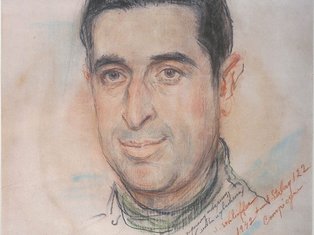Isis Kischka
1973-1908
Isis Kischka was born in Paris on the 26 October 1908 to a Jewish family who had migrated from the Ukraine two years earlier. After completing studies in commerce he became interested in painting and became an artist in 1926, working first as a designer of medals. He married in 1932 and three years later began to study at the Académie de la Grande Chaumière. His main sources of inspiration were Van Gogh and Cézanne. His paintings and colourful lithographs caught the attention of the prestigious art critics Jean Cassou and George Waldemar, the latter comparing Kischka's style to "the song of the nightingale". In 1938 Kischka's works were exhibited for the first time at the Salon des Indépendants and subsequently at the Salon d'Automne.
In 1941 Kischka was arrested and interned in Compiègne. While there, he painted scenes of the camp and portraits of his fellow inmates, and he encouraged other artists among the inmates to do likewise. He became a central figure in the artistic activity of the camp, organizing exhibitions and winning the highest esteem of fellow artists like Jacques Ostrowsky and Savely Schleifer, who dedicated several of their works to him. From Compiègne he was transferred to Drancy, but managed to avoid deportation to the death camps.
In the fall of 1944, after 39 months of internment, Kischka was freed and returned to Paris. Some time after his return he founded, together with art critic Jean Cassou and curator Yvon Bizardel, an association called "Artists Witness their Time". Their first exhibition was held in 1951 and included works by Henri Matisse, Georges Rouault, Raoul Dufy and Moïse Kisling. Kischka devoted his time to running the association's gallery, refusing to exhibit his own works there. But this did not prevent him from continuing with his own artistic work and from showing elsewhere. His landscapes, portraits and still life paintings were exhibited from 1956, first in a one-man show at the Nantes gallery and a year later at the Parisian gallery of Saint Placide. Subsequently, his works would be seen in galleries throughout France and in other countries. His extensive artistic and public activities were cut short in December 1973, when he died in Paris after a severe illness.
Kischka managed to save his paintings from the period of his internment, as well as the works of other artists - Jacques Gotko, David Brainin, Abraham Joseph Berline, Savely Schleifer and Jacques Ostrowsky. He donated several of these works to the art collection of Beit Lohamei Haghetaot (Ghetto Fighters' House Museum).
(Dr Pnina Rosenberg)
References
Jean Cassou and George Waldemar. "Kischka", les cahiers de la peinture, no. 1 (mai 1957), Paris.
Jean Bouret. "Isis Kischka" in Les cahiers d'Art-Document, no. 81, (1958) Genéve.
Robert Rey et al. Vision sur Kischka. Béziers, 1966.
Miriam Novitch. Spiritual Resistance – 120 Drawings from Concentration Camps and Ghettos 1940-1945. The Commune of Milan, Milan, 1979.
Miriam Novitch. Spiritual Resistance: Art from Concentration Camps 1940-1945 - A selection of drawings and paintings from the collection of Kibbutz Lohamei Haghetaot. Union of American Hebrew Congregations, 1981.
Kenneth E. Silver and Romy Golan. The Circle of Montparnasse: Jewish Artists in Paris 1905-1945. The Jewish Museum, Universe Books, New York, 1985.
Résistance-Déportation: Création dans le bruit des armes. Chancelerie de l'Ordre de la Liberation. Paris, 1980.


© Beit Lohamei Haghetaot,
Museum number 1729
Donated by the artist, Isis Kischka

© Beit Lohamei Haghetaot,
Museum number 1728
Donated by the artist, Isis Kischka

© Beit Lohamei Haghetaot,
Museum number 1726
Donated by the artist, Isis Kischka

Museum number 1712
Donated by the artist, Isis Kischka

Museum number 1726
Donated by the artist, Isis Kischka

Museum number 1720
Donated by the artist, Isis Kischka

Museum number 1726
Donated by the artist, Isis Kischka

© Beit Lohamei Haghetaot,
Museum number 1714
Donated by the artist, Isis Kischka

Museum number 1715
Donated by the artist, Isis Kischka

Museum number 1716
Donated by the artist, Isis Kischka

Museum number 1717
Donated by the artist, Isis Kischka

Museum number 50454
Donated by the artist, Isis Kischka
